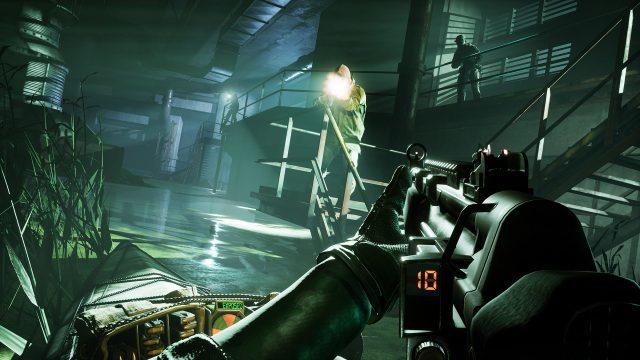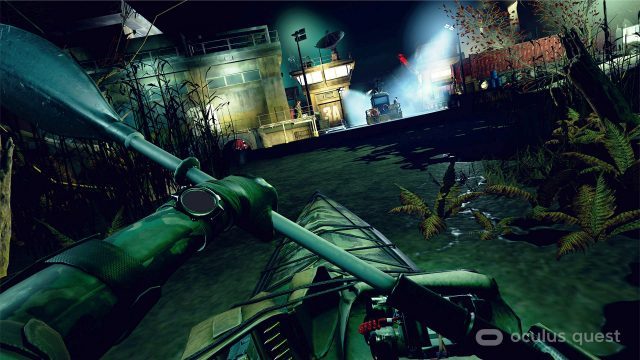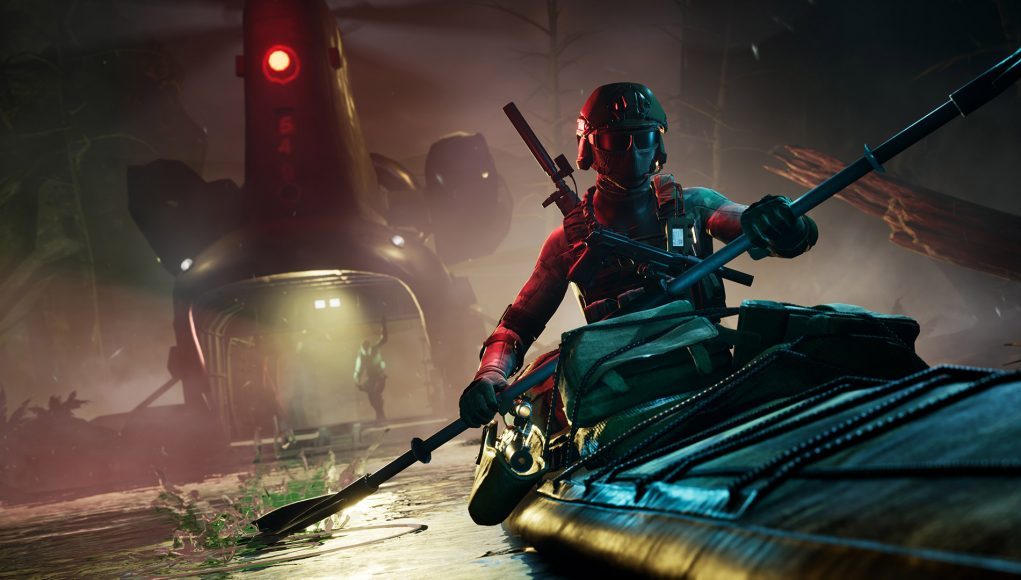Phantom: Covert Ops is a rather unique take on a stealth action game, and one that’s clearly been designed with virtual reality in mind. With paddle in hand, you’ll find yourself sleuthing through sluices in a tactical kayak. But are the waterways a welcoming venue for fun stealth action? Read on to find out.
Phantom: Covert Ops Details:
Publisher: Oculus Studios
Developer: nDreams
Available On: Oculus Store (Rift, Quest)
Reviewed On: Rift S, Quest
Release Date: June 25th, 2020
Price: $30 (supports cross-buy)
Gameplay
Phantom: Covert Ops is built entirely around being in a tactical kayak—which is just like a normal kayak, except that it’s camouflaged and has some deadly guns and gadgets attached. Throughout the game’s campaign you’ll find yourself paddling through shadowy spillways, distracting guards, and destroying key objectives. The story is nothing you haven’t heard before: a bad guy (who’s just evil because… why not) wants to hurt some good guys, and it’s your job to stop him.
The core gameplay involves following objective markers along a quite linear path which will sometimes be blocked by guards at the water’s edge. Stealth tends to be the best option because when the bullets start flying you’re mostly a sitting duck in the kayak. Luckily you can slip under docks and into reeds to stay concealed, and occasionally you’ll need to dodge a flashlight or security camera as you slide from one hiding spot to the next.
As you paddle around, you can pull out your night vision goggles; with the click of a trigger they’ll ‘mark’ any guards and interactive objects in the area. Unfortunately there isn’t a particularly large variety of objects. There’s things that distract guards (like an air canister or … a box-shaped air canister), generators which can be disabled to turn off lights, and explosive barrels.

These are your tools for dealing with guards, boats, and security cameras that watch the water’s edge. If you do get spotted, you have a brief moment to take down the guard that spotted you, otherwise they’ll alert the other guards too.
As for tackling objectives, you’ll be regularly asked to slip underneath structures like satellite dishes to disable them, and occasionally you’ll use explosive charges to blow up other objectives.
While Phantom: Covert Ops starts out strong with solid mechanics and interactions, the mechanics and the ensuing scenarios plateau pretty quickly.
It didn’t take long before the gameplay felt formulaic; I would enter a new area, mark everything in the vicinity with my night vision goggles, and then either slip past the guards undetected or create some small distraction and then go along my way. If I was feeling lazy I’d just drop a lone guard with my silenced pistol or sniper rifle. There was little sense of planning & executing, resource management, or overall strategy.
I was happy to see when the game finally introduced mines and security cameras—the sort of things that pushed the challenge and intrigue up a notch by requiring me to make more deliberate moves—but unfortunately that’s pretty much where the gameplay arc plateaued. About half way through the game I bumped up the difficulty from its medium setting to its highest setting which made things a little bit more interesting.
While Phantom: Covert Ops has some strong gameplay ideas, it doesn’t manage to get them to synergize particularly well; the gameplay sandbox isn’t quite dynamic enough to support the kind of thrilling scenarios that you’d expected from a great stealth action game.
Beyond the campaign mode, which took me around four hours to complete, there’s also Free Play mode and Challenges.
Free Play allows you to replay any level to try to improve your score (which is determined by factors like how many times you’ve been spotted) and you get to select your own loadout from equipment that you unlock throughout the campaign. You can also enable any of a few dozen cheats (like big head mode, super difficulty, unlimited ammo, low gravity, etc) in Free Play. Earning a high score on levels in Free Play (or the campaign mode) will unlock one of 14 challenges.
Challenges are mini-games that grade you based on time or score, and they’re actually worth a spin. Though they only take a minute or two each, they’re fun little extras like racing through a series of gates to score the best time, a range of pop-up targets to test your marksmanship, or a challenge to kill all guards along a path. Each challenge has leaderboards, so you can see just how well you match up against everyone else.
The challenges typically push the game’s mechanics to more interesting extremes, but unfortunately they smack of gameplay beats which couldn’t be effectively integrated with the main campaign.
Immersion
The core interaction and locomotion design of Phantom: Covert Ops is inherently quite immersive. Being in the kayak and paddling your way along the water feels really good. The way that weapons and gadgets are attached to your kayak around you and right within arms reach makes for a perfectly intuitive inventory system that’s always right where you expect it to be.
If there’s a lever or latch to pull, it almost always feels satisfying, and nDreams thoughtfully placed extra hand-holds near key switches and levers which makes it easy to grab hold of and pull yourself in closer for the interaction.
Weapon handling also feels quite good. The weapon models are reasonably high quality and the game applies a smoothing effect to the movement of your hands depending upon how heavy the weapon is. That prevents weapons from wiggling unrealistically, and provides a sense of virtual weight. You can also two-hand pistols right along with the explicitly two-handed weapons like the SMG and sniper rifle.
But there’s a few misses too. While the weapons look good, their actual use and mechanics are quite arcade-y. If you release any object like a gun or your paddle, it instantly snaps back into its holster. While this is of course convenient, it means you don’t need to focus too much attention on managing the items around you. You can, for instance, aim your sniper rifle and then simply release it to then reach for the SMG on your back (knowing that the sniper rifle will just pop back into its holster).
Reloading weapons also feels awkward (and even unnecessary). Throughout the whole campaign I think I might have reloaded each weapon a single time (there’s just not much need to shoot). You do so by grabbing a magazine from the pouch in front of you, and then moving it toward the magazine on the gun. Then you’ll watch as the old mag magically ejects and the new one pops into its place.
This is made more awkward by the poor hand-posing on the magazines; the way the hand clasps most magazines means that you’ll probably bump your controllers together when you try to put the new mag in—it’s as if the developers were exclusively building the game on the original Rift CV1 (which had controllers with rings facing down instead of up like on Rift S and Quest controllers).
A greater emphasis on those near-field interactions with weapons and gadgets could have been a great way to diversify the gameplay and move the player’s attention between more than just looking out for guards and the next hiding spot.
Unfortunately the game’s trite story doesn’t help on the immersion front. After playing the game’s four hours of campaign, I recall the names of two characters—neither of which were interesting in the slightest due to a complete lack of character development. In fact, I found some of the throw-away guard dialogue more interesting than whatever the main characters (AKA voices on the radio) were up to.
The game’s sound and visual design are passable, but left me wanting. I found the game’s lighting to be often confusing, both visually and mechanically. In many cases, light seems to emanate from no source in particular, leaving the environment often looking light a patchwork of oddly lit and unlit spaces. And then there were places that seemed perfectly bright but I could easily go undetected right in front of a guard while waving at them in jest. P.S. Do yourself a favor and disable anti-aliasing; the reduction in aliasing isn’t worth how much sharpness the game sacrifices.
On Quest specifically, the headset’s OLED black-smear issues are truly exacerbated by the game. Dark areas of the scenes get smeared around a good bit during head movement, largely defeating the benefit of having the OLED display in the first place. The game is still playable, but I’m hoping this could get patched in the future to prevent the game from using true-black so often (thereby hopefully reducing smearing).
Sound in Covert Ops is a mixed bag too. At the start of the game you’ll see a big pop-up that says “Headphones recommended.” And you should absolutely follow that advice for an instant boost to immersion (though that’s more on the sub-par speakers of Rift S and Quest than anything else). Even with headphones, sounds in the game don’t seem particularly well polished—like the very uneventful sound effects for when you’ve been detected or the sound of incoming gunfire when you’re being shot at.
Comfort

I was quite worried about the comfort of Phantom: Covert Ops in my most recent preview because the game’s smoothly turning ‘sharp turn’ mechanic clearly grated on my brain. Too much of that smooth turning and it would be a trip to nausea town.
I’m very happy that the studio has added an ‘incremental turn’ option which causes the kayak to snap-turn when you employ the ‘sharp turn’ button. Although the motion doesn’t feel as natural as smooth turn, I found that it was a hell of a lot more comfortable and that it had almost no impact on gameplay. Thanks to the incremental turn option, I could play Covert Ops indefinitely without the risk of nausea slowly building.
Thanks to the addition of incremental turn, I found the game very comfortable throughout.
Those who are highly sensitive to motion might take issue with ‘strafe’ paddling (which can slide the kayak sideways) or when using the paddle to push against the shore to move the kayak, though both can be avoided easily with almost no impact to gameplay.
I also didn’t notice a single instance where tracking was an issue—either when reaching for objects in my inventory or using the two-handed sniper rifle—which means that nDreams designed around the inside-out tracking limitations of Rift S and Quest very well.
As a seated game, Phantom: Covert Ops can be played easily in a fairly compact playspace. While I started out sitting on the floor, eventually my back got a bit sore due to no support. I stuck an arm-less chair in the middle of my playspace for the second half of the game and much preferred the back support.







